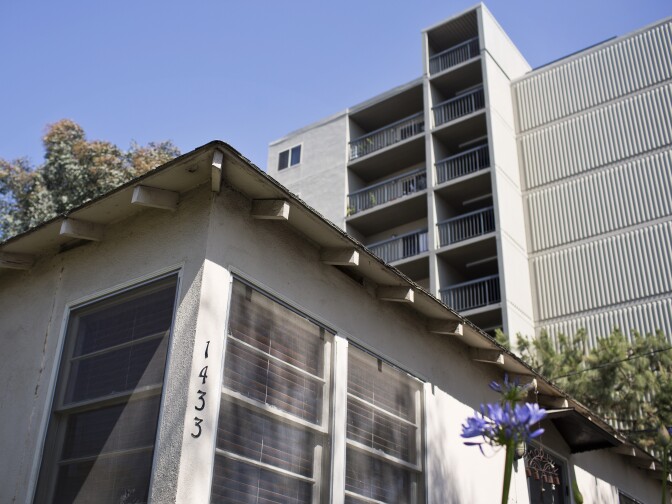This story is free to read because readers choose to support LAist. If you find value in independent local reporting, make a donation to power our newsroom today.
This archival content was originally written for and published on KPCC.org. Keep in mind that links and images may no longer work — and references may be outdated.
SoCal needs to build more homes, but 'density' is a tough sell
As the Santa Monica City Council prepares to approve a new zoning ordinance that will allow taller buildings in its downtown district, some residents of the area are worried it will change the character of their city.
Council members have said the re-zoning is needed to bring more housing stock to the area and stabilize skyrocketing rents and home prices. The city's population grew by almost 7 percent from 2000 to 2010, more than double the rate in L.A. That means competition is fierce to find a home, which has pushed the average rent for a one-bedroom apartment past $2,600, the highest in L.A. County.
“Coastal areas need to develop housing. We need to develop housing," said council member Gleam Davis at a recent hearing. "If we’re going to try and not turn our existing neighborhoods into the killing fields of people clicking out existing tenants, we need to give that development pressure a place to go.”
Housing experts say lots of cities in Southern California will eventually have to confront that same reality — though it is sure to rattle residents. Southern California is synonymous with sprawl — and the single-family home — but there are few open parcels of land that can still be developed while being reasonably close to jobs.
"Here's what my Santa Monica looks like"
Architect Mario Fonda-Bonardi drives down Broadway, pointing out the many one- and two-story offices and shops lining a familiar street in Santa Monica. He's lived in the city for decades and still refers to it as a "beach town."
His tone changes when passing by a five-story complex with shops on the street-level and housing on top.
"If the city looked like that building right there, wouldn’t you be saying, 'Damn, I don’t live in Santa Monica anymore'?” he says.
This is what's making thousands of people mad in Santa Monica. This five-story mixed-use development complex is on 5th St between Broadway and Santa Monica Blvd. The building has retail spaces on the ground level and residential units on the floors above. (Leo Duran/KPCC)
Density is destiny for SoCal, say analysts
Southern California's housing problem is partly a creation of its own success.
Combine pleasant weather with the wealth of job opportunities. Add in decades of people achieving their dream of owning a home and the allure of Hollywood, and Southern California became a popular destination.
Sprawl has its limits, however, because people will only drive so far to get to and from their house. Selling density isn't easy either, because longtime residents rarely want their neighborhood to radically change.
"It took us about seven months to find this house," Pasadena homeowner Becky Galaviz says, proudly standing in front of her quaint bungalow with a fenced yard and driveway. She can't imagine living anywhere else.
Two doors down, though, a 20-unit affordable housing complex is breaking ground.
"I think the whole block is going to end up being apartments, so we’re just being kind of kicked off," she says, waiting for the day a developer knocks on her door to buy her out.
Developers say they know big buildings are a tough sell to future neighbors, and so there is a multi-layered strategy to win them over. For example, the L.A. Community Development Commission, which helped fund the project, talked with community leaders early on to get them involved and invested in the process.
They will also get creative with the design to make the future building a better fit for the neighborhood.
"Sometimes it’s gathering attention and focusing it in the right places," says architect Steve Kuchenski. For this particular project, he made the parts of the building that face the street only two stories. It steps up to three beyond that, but that story is harder to see from the sidewalk. He also set the building back from the curb so there would be more greenery and trees to draw people's eyes to the ground level instead of the sky.
A rendering of the Mar Vista Union apartments in Pasadena. It broke ground in April 2015 with an expected completion in Summer of 2016 (courtesy of National Community Renaissance)
Kuchenski says it's still dense, but these tactics help to make it not seem that big. But many housing analysts still say people everywhere react badly to the "D" word.
“When people hear density, I think they immediately imagine that they’re going to be in Manhattan," says USC's Raphael Bostic. "I think that’s a mistake but we haven’t found a good language around that."
However, there is a "developer" speak emerging that uses key words to get communities on board.
At the Del Mar Gold Line Station in Pasadena, for example, is a multifamily building that houses 347 families. The architect describes it as a "mixed-use village" with a "plaza" and "open-air courtyards" that "foster a sense of the community."
Read between the lines, and that's code for a pleasant and communal addition to your neighborhood. Other developments might emphasize how they are “pedestrian-” and “bike-friendly.” That suggests that the buildings won't create more car traffic and congestion on the block.
Some people will never be sold on density
Santa Monica resident Mario Fonda-Bonardi says even with all that, he’s just not sold.
He is fine with building bigger in places like Brentwood or West L.A., but he's a proud NIMBY – which stands for "Not in My Backyard."
“NIMBYism, by itself, is not a bad thing if you’re preserving a city and a city’s character for everybody," he says, adding that there's a lot at stake in Santa Monica's zoning fight. "Everyone’s going to the mat on this one because the next 20 years may be a real turning point in the history of the city.”
Officials in Santa Monica, however, say that when it comes to adequate housing stock and affordable prices, they’re not staring off a cliff: they already walked off the edge.
To keep from crashing down, they need to look up. They are expected to approve the zoning proposal Tuesday.
















